Norse Creation and Destruction of the World
- Details
- Written by AndEl
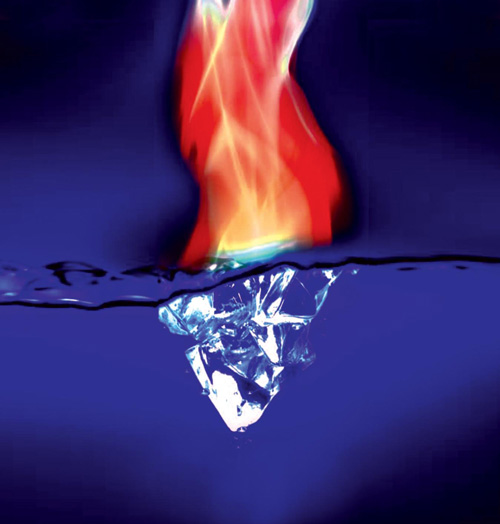
World of Fire and Ice
Originally there was a chasm, Ginnungagap, bounded on either side by fire (from the world known as Muspelheim) and ice (from the world known as Niflheim).
Ymir
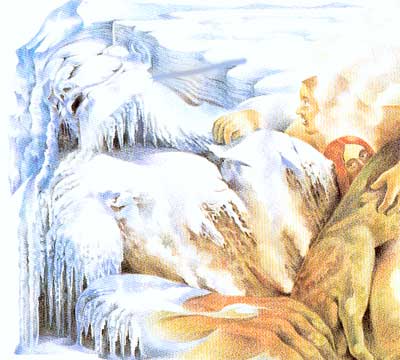 In Norse mythology, Ymir is the primordial giant and the progenitor of the race of frost giants. He was created from the melting ice of Niflheim, when it came in contact with the hot air from Muspell. From Ymir's sleeping body the first giants sprang forth: one of his legs fathered a son on his other leg while from under his armpit a man and women grew out.
In Norse mythology, Ymir is the primordial giant and the progenitor of the race of frost giants. He was created from the melting ice of Niflheim, when it came in contact with the hot air from Muspell. From Ymir's sleeping body the first giants sprang forth: one of his legs fathered a son on his other leg while from under his armpit a man and women grew out.
The frost kept melting and from the drops the divine cow Audumla was created. From her udder flowed four rivers of milk, on which Ymir fed. The cow itself got nourishment by licking hoar frost and salt from the ice. On the evening on the first day the hair of a man appeared, on the second day the whole head and on the third day it became a man, Buri, the first god. His grandchildren are Odin, Ve and Vili.
Odin and his brothers had no liking for Ymir, nor for the growing number of giants, and killed him. In the huge amount of blood that flowed from Ymir's wounds all the giants, except two, drowned. From the slain body the brothers created heaven and earth. They used the flesh to fill the Ginnungagap; his blood to create the lakes and the seas; from his unbroken bones they made the mountains; the giant's teeth and the fragments of his shattered bones became rocks and boulders and stones; trees were made from his hair, and the clouds from his brains. Odin and his brothers raised Ymir's skull and made the sky from it and beneath its four corners they placed a dwarf. Finally, from Ymir's eyebrow they shaped Midgard, the realm of man. The maggots which swarmed in Ymir's flesh they gave wits and the shape of men, but they live under the hills and mountains. They are called dwarfs.
Bergelmir
In Norse myth, Bergelmir was the son of Thrudgelmir and the grandson of Aurgelmir (Ymir). In the enormous amount of blood which flowed freely after Ymir's death, all the frost giants died, except Bergelmir and his wife. Just before the end they climbed into a hollow tree trunk and could thus survive. When things settled down, they became the progenitors of a new, younger race of frost giants.
Jormungand
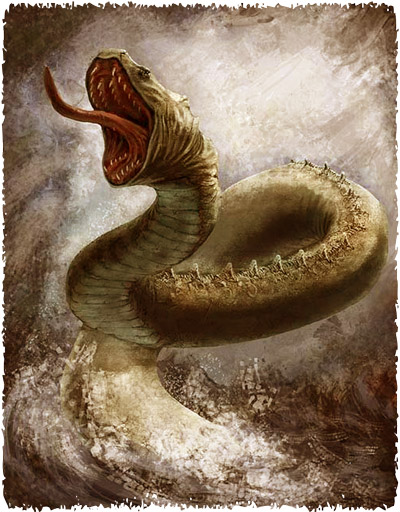 In Norse mythology, Jormungand is one of the three children of the god Loki and his wife, the giantess Angrboda. The gods were well aware that this monster was growing fast and that it would one day bring much evil upon gods and men. So Odin deemed it advisable to render it harmless. He threw the serpent in the ocean that surrounds the earth, but the monster had grown to such an enormous size that it easily spans the entire world, hence the name Midgard Serpent. It lies deep in the ocean where it bites itself in its tail, and all mankind is caught within his coils.
In Norse mythology, Jormungand is one of the three children of the god Loki and his wife, the giantess Angrboda. The gods were well aware that this monster was growing fast and that it would one day bring much evil upon gods and men. So Odin deemed it advisable to render it harmless. He threw the serpent in the ocean that surrounds the earth, but the monster had grown to such an enormous size that it easily spans the entire world, hence the name Midgard Serpent. It lies deep in the ocean where it bites itself in its tail, and all mankind is caught within his coils.
At the destruction of the universe, Jormungand and Thor will kill each other.
Yggdrasil
From Ymir's body grew an ash tree named Yggdrasil whose branches covered the known world and supported the universe. Yggdrasil ("The Terrible One's Horse"), also called the World Tree, is the giant ash tree that links and shelters all the worlds.
Ygdrasil had three roots going to each of the 3 levels of the world. One root went into Asgard, the home of the gods, another went into the land of the giants, Jotunheim, and a third went to that primeval world of ice, darkness, and the dead, known as Niflheim. Three wells lie at its base: the Well of Wisdom (Mímisbrunnr), guarded by Mimir; the Well of Fate (Urdarbrunnr), guarded by the Norns; and the Hvergelmir (Roaring Kettle), the source of many rivers.
Four deer run across the branches of the tree and eat the buds; they represent the four winds. There are other inhabitants of the tree, such as the squirrel Ratatosk ("swift teeth"), a notorious gossip, and Vidofnir ("tree snake"), the golden cock that perches on the topmost bough. The roots are gnawed upon by Nidhogg and other serpents. On the day of Ragnarok, the fire giant Surt will set the tree on fire.
Other names for the tree include: Ask Yggdrasil, Hoddmimir's Wood, Laerad and Odin's Horse.
Old Norse: Mimameidr
The Three Norns
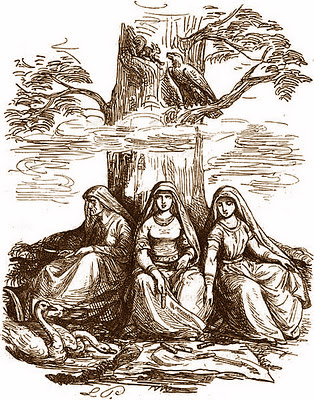
In Norse mythology, the Norns are the demi-goddesses of destiny. They control the destinies of both gods and men, as well as the unchanging laws of the cosmos. They are represented as three sisters: Urd ("fate"), Verdandi ("necessity") and Skuld ("being"). They live at the base of the World Tree Yggdrasil in the realm of Asgard.
Nothing lasts forever, and even the mighty Yggdrasil is subject to decay. The Norns try to stop this process, or at least slow it down, by pouring mud and water from the Well of Fate over its branches. This magical liquid stops the rotting process for the time being.
In other myths, the Norns were thought to give assistance at birth, and that each person has his own personal Norn.
The spring by the Asgard root was cared for by the 3 Norns, goddesses of fate:
* Urdur (the past)
* Verdandi (the present), and
* Skuld (the future)
The Nine Worlds of Norse Mythology
In Norse mythology there are 9 worlds that are divided among three levels all held together by the world tree, Ygdrasil.
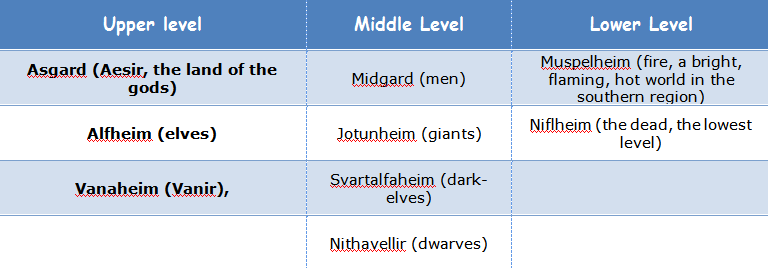
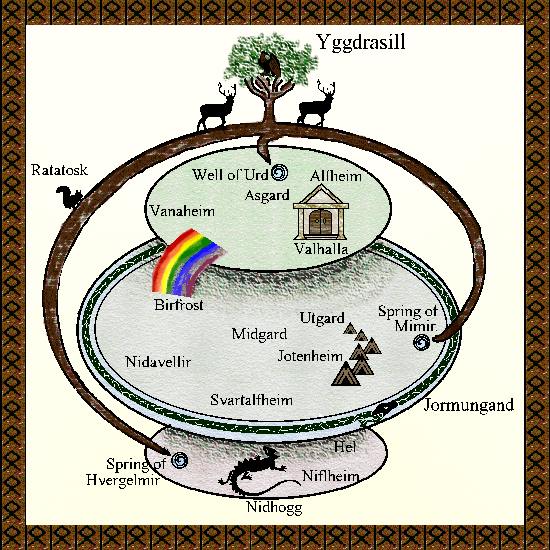
Upper Level
Asgard
Asgard, in Norse mythology, is one of the nine worlds and the homeland of the Aesir, the race of warrior gods. Located on the highest level of the Norse universe, it is surrounded by a high wall of closely fitted stone blocks. The walls surrounding Asgard were built by Blast (or Hrimthurs), who asked in payment the hand of Freya plus the sun and the moon. Odin agreed providing the walls be complete in six months. Hrimthurs had a magic horse, named Svadilfari, who helped him in his work. To Odin's (and the other gods, especially Freya's) horror, with but a few days left, Blast was almost finished. Loki, the trickster, turned himself into a mare and beguiled the stallion Svadilfari away. The job was not completed in time and no payment was given.
Also found on this level are the worlds of Alfheim and Vanaheim as well as Valhalla, an immense hall where warriors slain in battle await the final conflict.
In the middle of Asgard lies the plain of Idavoll (or Ida) where the Aesir meet to decide important issues. There the gods assemble in the hall of Gladsheim and the goddesses in the hall of Vingolf. The gods also meet daily at the Well of Urd, beneath the Asgard root of the ash tree Yggdrasil.
Alfheim
Alfheim ("elf home"), in Norse mythology, is one of the nine worlds. It is located on the highest level of the Norse universe. Also found on this level are the worlds of Asgard and Vanaheim. Alfheim is the palace of the god Freyr and the homeland of the elves of light. Neither the elves of light nor the elves of darkness, who live in Svartalfheim, participate in any of the events described in the Norse myths. Elves do, however, have active roles in the literature of quite a few of the other branches of Indo-European mythology.
Vanaheim
Vanaheim ("home of the Vanir") is the land of the Vanir. It is located in Asgard, on the highest level of the universe.
Valhalla
Valhalla, Hall of the Slain, in Norse mythology is the hall presided over by Odin. This vast hall has five hundred and forty doors. The rafters are spears, the hall is roofed with shields and breast-plates litter the benches. A wolf guards the western door and an eagle hovers over it. It is here that the Valkyries, Odin's messengers and spirits of war, bring half of the heroes that died on the battle fields (the rest go to Freya's hall Folkvang). These heroes, the Einherjar, are prepared in Valhalla for the oncoming battle of Ragnarok. When the battle commences, eight hundred warriors will march shoulder to shoulder out of each door.
Old Norse: Valhöll
Middle Level
Midgard
In Norse myth, the defensive fortress which the gods build about the middle portion of the earth allotted to men in order to protect mankind from the giants. Midgard ("middle world") is on the same level as Nidavellir (land of the dwarfs), Svartalfheim (land of the dark elves/dwarfs) and Jotunheim (the land of the giants).
Jotunheim
Jotunheim is one of the nine worlds, the homeland of the frost giants and rock giants. Situated in Midgard, on the middle level of the Norse universe, Jotunheim is separated from Asgard by the river Iving, which never freezes over. It lies in the snowy regions on the outermost shores of the ocean. Mimir's well of wisdom is in Jotunheim, beneath the Midgard root of the ash tree Yggdrasil.
Jotunheim is ruled by Thrym ("uproar"), the feared king of the frost giants. The stronghold of Utgard, the chief city of Jotunheim and the abode of the giants, is ruled by the giant Utgard-Loki. Other strongholds include Gastropnir, home of the giantess Menglad, and Thrymheim ("house of uproar"), mountain stronghold of the giant Thiazi.
Svartalfar
The black elves of Norse mythology who grew from the maggots of Ymir's flesh. They live in the earth and in stones. Although they have the shape of men, they are often misshapen. Their home is Svartalfheim, which lies under the earth, and here they stay during daylight on pain of being turned to stone.
The Svartalfar are often identified with the dvergar (dwarfs) and are hard to distinguish from the Döckálfar (the earth-dwelling ones).
Lower Level
Niflheim
Niflheim ("house of mists") is the far northern region of icy fogs and mists, darkness and cold. It is situated on the lowest level of the universe. The realm of death, Helheim is part of the vast, cold region. Niflheim lies underneath the third root of Yggdrasil, close to the spring Hvergelmir ("roaring cauldron"). Also situated on this level is Nastrond, the Shore of Corpses, where the serpent Nidhogg eats corpses and gnaws on the roots of Yggdrasil.
After Ragnarok, there will be a hall here for the punishment of murderers, oath breakers, and philanderers.
Helheim
Helheim ("house of Hel") is one of the nine worlds of Norse mythology. It is ruled by Hel, the monstrous daughter of the trickster god Loki and his wife Angrboda.
This cold, dark and misty abode of the dead is located in the world of Niflheim, on the lowest level of the Norse universe. No one can ever leave this place, because of the impassable river Gjoll that flows from the spring Hvergelmir and encircles Helheim. Once they enter Helheim, not even the gods can leave. Those who die of old age or disease, and those not killed in battle, go to Helheim while those who die bravely on the battlefield go to Valhalla.
The entrance to Helheim is guarded by Garm, a monstrous hound, and Modgud. The giant Hraesvelg ("corpse eater") sits at the edge of the world, overlooking Helheim. In the form of an eagle with flapping wings he makes the wind blow.
Old Norse: Niflheimr
The Gods' Death
The Norse gods are not immortal in the normal sense. In the end, they and the world will be destroyed because of the actions of the evil or mischievous god Loki who, for now, endures Promethean chains. Loki is the son or brother of Odin, but only through adoption. In reality he is a giant (Jotnar), one of the sworn enemies of the Aesir. It is the Jotnar who will find the gods at Ragnarok and bring about the end of the world.
Ragnarok
Ragnarok ("Doom of the Gods"), also called Gotterdammerung, means the end of the cosmos in Norse mythology. It will be preceded by Fimbulvetr, the winter of winters. Three such winters will follow each other with no summers in between. Conflicts and feuds will break out, even between families, and all morality will disappear. This is the beginning of the end.
The wolf Skoll will finally devour the sun, and his brother Hati will eat the moon, plunging the earth [into] darkness. The stars will vanish from the sky. The cock Fjalar will crow to the giants and the golden cock Gullinkambi will crow to the gods. A third cock will raise the dead.
The earth will shudder with earthquakes, and every bond and fetter will burst, freeing the terrible wolf Fenrir. The sea will rear up because Jormungand, the Midgard Serpent, is twisting and writhing in fury as he makes his way toward the land. With every breath, Jormungand will stain the soil and the sky with his poison. The waves caused by the serpent's emerging will set free the ship Naglfar, and with the giant Hymir as their commander, the giants will sail towards the battlefield. From the realm of the dead a second ship will set sail, and this ship carries the inhabitants of hell, with Loki as their helmsman. The fire giants, led by the giant Surt, will leave Muspell in the south to join against the gods. Surt, carrying a sword that blazes like the sun itself, will scorch the earth.
Meanwhile, Heimdall will sound his horn, calling the sons of Odin and the heroes to the battlefield. From all the corners of the world, gods, giants, dwarves, demons and elves will ride towards the huge plain of Vigrid ("battle shaker") where the last battle will be fought. Odin will engage Fenrir in battle, and Thor will attack Jormungand. Thor will victorious, but the serpent's poison will gradually kill the god of thunder. Surt will seek out the swordless Freyr, who will quickly succumb to the giant. The one-handed Tyr will fight the monstrous hound Garm and they will kill each other. Loki and Heimdall, age-old enemies, will meet for a final time, and neither will survive their encounter. The fight between Odin and Fenrir will rage for a long time, but finally Fenrir will seize Odin and swallow him. Odin's son Vidar will at once leap towards the wolf and kill him with his bare hands, ripping the wolf's jaws apart.
Then Surt will fling fire in every direction. The nine worlds will burn, and friends and foes alike will perish. The earth will sink into the sea.
After the destruction, a new and idyllic world will arise from the sea and will be filled with abundant supplies. Some of the gods will survive, others will be reborn. Wickedness and misery will no longer exist and gods and men will live happily together. The descendants of Lif and Lifthrasir will inhabit this earth.
Ragnarök does not mean "Twilight of the Gods"; that phrase is the result of a famous mistranslation. "Ragnarökr" or "Ragnarøkr" means "doom of the powers" or "destruction of the powers" (where "powers" means "gods").
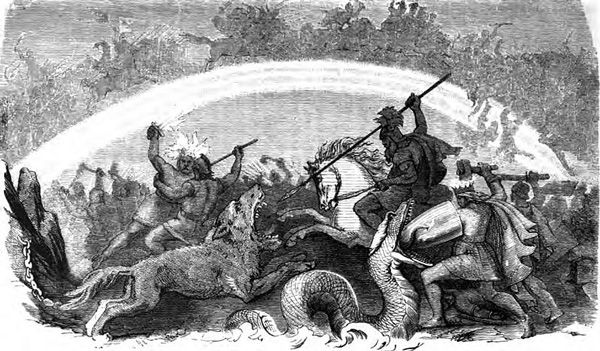
Primary Source for this article: Encyclopedia Mythica. 2010. Encyclopedia Mythica Online. 03 Dec. 2010 .
by Micha F. Lindemans
Primary Source Here
Liked this article? Dive deeper into personal growth and wellness! Check out CrystalWind.ca for spiritual wisdom or explore AromaWorx.ca for natural well-being tips. Spread the positivity—share this with friends on their happiness journey!
Let’s Chat! Drop Your Thoughts Below! ![]()
Latest Articles
Dive into the Mystical World of the Crystal Wind Oracle Deck!
Get All the Enchanting Details Now!
NEW Expanded Boxed Edition!
Now with 58 Cards for Richer Wisdom!
Imagine a world of inspiration and healing, free for all—made possible by YOU!
Donate Now—Ignite the Magic at CrystalWind.ca!

Epilepsy - Finding A Cure
Your donation can make a difference!
Help us find a cure – donate now!
Unlock Your Light: Join Lightworkers Worldwide on CrystalWind.ca!
Follow Us!
Featured This Month
Cancer Mythology
The Mythology of Cancer: A Celestial Tale of Loyalty and Sacrifice Among th... Read more
Lammas by The Hedgewitch
Although in the heat of a Mid-western summer it might be difficult to discer... Read more
Chalcedony
The Stone Of Orators Chalcedony was very popular as a decorative stone in ant... Read more
Abalone Shell
Echos Of The Ancestors Abalone strengthens the structure of the body and th... Read more
Lugh - Celtic God Of The Sun
The god Lugh was worshiped in Ireland as a deity of the sun. This connection... Read more
Sun in Cancer
Cancer Sun Sign Characteristics Overview The name "Cancer" comes from Latin, ... Read more
Egyptian Zodiac/Astrology
Egyptian astrology was one of the earliest forms of astrology. The Egyptians w... Read more













































